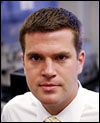Four under 35 years old land on ‘TR35’ list
Massachusetts Institute of Technology’s Technology Review magazine recently named four Harvard researchers to its 2005 list of top technology innovators under the age of 35. According to the magazine, the “TR35” will shape our world for decades to come.
The Harvard winners are as follows:

Martha Bulyk, 33, is an assistant professor of medicine, pathology, and health sciences and technology at Harvard Medical School. Technology Review honored Bulyk for her efforts in discovering how genes are regulated. Taking the gene chip technology originally developed to measure gene activity, she has adapted it to determine the DNA binding preferences of proteins. The technology replaces painstaking assays with efficient screens, which could aid research on diseases that are affected by mutations in transcription factors or in their binding sites, such as hypertension, cancer, and diabetes.

Kevin Eggan, 31, an assistant professor of molecular and cellular biology at the University, made the list for using cloning to study degenerative diseases. While earning his Ph.D., Eggan helped make Rudolf Jaenisch’s lab at the Whitehead Institute for Biomedical Research a preeminent cloning lab. He used those skills to clone mice from neurons, proving that animals could be cloned from even the most specialized cells in the body. Eggan also helped explain how cloning “reprograms” the genetic material from an adult mouse cell, identifying the changes that take place to reset the nucleus to the beginning of development. He plans to create human stem cell lines from patients with neurodegenerative disorders such as Parkinson’s and Lou Gehrig’s diseases in order to study disease development and search for new drugs.
Anita Goel, 32, associate of the Department of Physics, was honored for building novel pathogen detectors. As a physics graduate student at Harvard, Goel developed a theory to explain how these molecular motors work. While working on her medical degree at Harvard in 2004, she founded Nanobiosym to apply her theories to the development of nanotech devices for precisely controlling these proteins; such devices could identify viruses and bacteria in, say, a blood sample more rapidly, accurately, and cheaply than current techniques can. Her goal: a low-cost, handheld device for biodefense and biomedical applications.
Shiladitya Sengupta, 33, an assistant professor at Harvard Medical School and Brigham and Women’s Hospital, was named to the TR35 for his advances in drug delivery to cancer cells. Developed during his postdoc at MIT and inspired by a children’s toy – several small balloons encapsulated in a bigger one – Sengupta’s drug delivery device consists of a lipid sphere about 200 nanometers wide surrounding smaller, biodegradable polymer spheres. These nanocells home in on cancers based on the unique characteristics of tumor blood vessels. The outer shells then dissolve, releasing a drug that destroys the vessels. As the cancer cells starve for oxygen, they secrete enzymes that break up the inner spheres, dispensing a standard chemotherapy agent. The nanocells have the potential both to treat tumors more effectively than existing regimes and to reduce side effects.
The nanocells have proved effective in mouse models of melanoma and lung cancer. Because Sengupta designed them using polymers and drugs already approved for human use, doctors can quickly move them into clinical trials. He is now extending the concept to treat other diseases.
– Andrew Brooks




